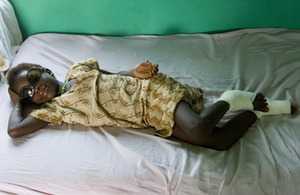Goodbye, Guinea worm
Metre long guinea worms caused Sadia agonising pain. Find out how UK aid is helping eradicate the disease

Getting better: Sadia recovering from daily treatments for the painful Guinea worms emerging from her feet. Picture: The Carter Center
UK aid is supporting an ongoing campaign by US non-governmental organisation, The Carter Center, to wipe out Guinea worm disease. The disease has been reduced by 99% in the last 25 years and could be eradicated by the end of this decade.
Four years ago, Sadia Mesuna was a 6 year old girl in agony as three painful Guinea worms emerged from her feet. Crippled by the disease, she missed months of school and fell so behind that she eventually dropped out. Now aged 10, and through the support of The Carter Center and UK aid, in partnership with the Ghana national program, Sadia is Guinea worm free and able to attend school again. What’s more, earlier this year her country, Ghana, declared that it had eliminated Guinea worm - a major triumph over a disease that had debilitated Ghanaians for centuries.
A disease of poverty
Guinea worm afflicts the world’s poorest and most isolated communities. While it is rarely fatal, it has catastrophic effects on those afflicted by it.
The disease is contracted through drinking water contaminated with microscopic Guinea worm larvae. About a year after drinking the contaminated water, a metre long spaghetti-like worm emerges from the afflicted person’s body through a blister in the skin. There is no vaccine or medication to treat Guinea worm. The only treatment is manual extraction of the worm - an agonising process that takes several weeks or even months.
Sadia lives in the town of Savelugu, Northern Ghana. In 2007, she was admitted to a treatment centre supported by not-for-profit US organisation, The Carter Center.
“It was very painful, especially when they were fixing my wounds. It’s more painful than stepping on fire coals or being cut. And you don’t feel like eating anything.”
Sadia had already been weakened by the disease before arriving at the treatment centre. The agonising pain left her unable to walk or to eat properly. She was unable to attend school and became very thin. The worms emerging from her skin left her with painful open wounds that put her at risk of other infections, such as tetanus.
No Guinea worm vaccine
With no vaccine or medicine available for Guinea worm besides manual extraction of the worm, Sadia had to remain in the treatment centre for two months and endure excruciating daily treatments to slowly remove the worms. The worms cannot be extracted quickly because if they were to break, the patient would be left with a worm stuck inside their body, potentially causing permanent disability.
Patients are simultaneously given advice on the risk of contamination, which is vital in stopping the further spread of the disease. If the worms come into contact with an open water source they can eject hundreds of thousands of larvae that could infect someone else, triggering an un-ending cycle of the disease.
While in the containment centre, patients are taught how Guinea worm is contracted and what to do to prevent the disease in future. The disease can be avoided by filtering or treating water before drinking. The Carter Center provides communities with simple household filters and individual pipe filters, similar to a straw, to allow people to protect themselves.
Getting back to school
“I’ll only drink filtered water from now on,” Sadia says. Free of the disease, Sadia could now resume her daily life again. But this was not to be simple. She had missed so much school through her illness that she was unable to catch up. However, with the support and encouragement of the Guinea worm staff and local officials, Sadia eventually returned to school and is now looking forward to taking her exams.
Facts and stats
Former US President Jimmy Carter has been a tireless campaigner for Guinea worm eradication since 1986. With his wife Rosalynn, he established The Carter Center in 1982, a not-for-profit organisation aimed at supporting human rights and alleviating human suffering.
In 1989, when Ghana first undertook its first national count of Guinea worm cases, 180,000 people were infected with the disease. In July 2011, Ghana announced that it had stopped the transmission of Guinea worm, meaning that no new cases of the disease had been reported for over a year. Once the disease cycle is broken in this way, a country has a real chance of eradicating the disease forever.
DFID has supported The Carter Center through accountable grants since 2008. In addition to supporting treatment of the disease, DFID also funds water and sanitation programmes in Africa and Asia to provide clean water supplies and safe sanitation and help prevent the spread of waterborne diseases.